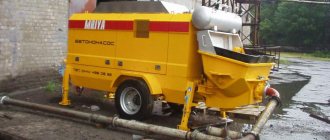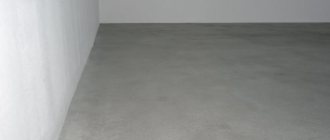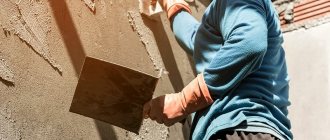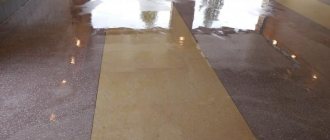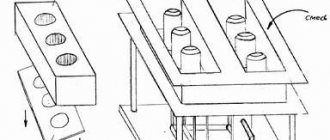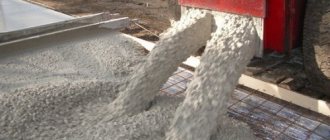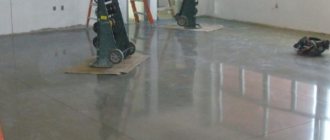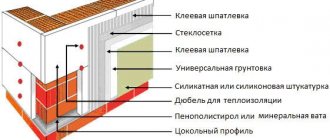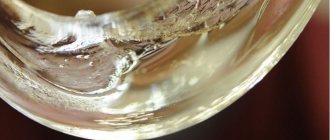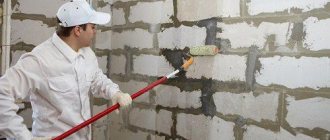The issue of developing compositions and technologies for producing building materials based on industrial and household waste has been exciting the minds of researchers working in the field of building materials for many years, and especially recently. Binders, concretes and products using various slags, sludge, ashes, wood chips, as well as construction waste generated during the demolition and reconstruction of buildings and structures have already been used. But the researchers don't stop there. After all, the relevance of developing compounds and materials using them is dictated not only by environmental, but also by economic factors. In recent years, along with already known and traditional waste in a certain sense, the recycling of unsorted broken artificial (technogenic) glass, or simply cullet, has attracted particular interest. The fact is that defects or broken glass formed during production are in most cases reused by the same factories. Such glass has a stable (within the framework of this technology) chemical composition and is used in the process of melting the charge. Unsorted scrap of various types of glass (window, container, optical, etc.) has a fairly wide range of chemical composition. Plus, foreign impurities are possible, the inclusion of which in the raw material mixture is not permissible if it is desired to obtain glass with a certain composition or quality. Therefore, unsorted cullet, which is formed in huge quantities in dumps and landfills, still does not find proper use. It should be noted that from an environmental point of view, glass is considered the most difficult waste to dispose of. It is not subject to destruction under the influence of water, atmosphere, solar radiation, or frost. In addition, glass is a corrosion-resistant material that does not collapse under the influence of an overwhelming amount of strong and weak organic, mineral and bioacids, salts, as well as fungi and bacteria. Therefore, if organic waste (paper, food waste, etc.) completely decomposes after 1-3 years, polymer materials - after 5-20 years, then glass, like steel, can be preserved without much damage for tens or even hundreds of years. The volume of unused cullet, according to the Institute of Secondary Resources, amounted to more than 2.5 million tons in 2000. In the Krasnoyarsk Territory alone, more than 1,650 tons accumulated in dumps. Among the variety of urban waste, cullet occupies one of the leading places, more than 20% of total quantity. Many leading research centers in Russia, the CIS countries and abroad have been actively working in the field of recycling cullet in recent years. For example, in the USA, $444 million (!) were allocated for research conducted by specialists from the Faculty of Engineering and Applied Sciences at Columbia University (New York) related to the problem of replacing stone aggregate in concrete with broken glass. For more than fifteen years at the Moscow State University of Civil Engineering (formerly MISS) at the Department of Technology of Finishing and Insulating Materials (TOIM), inventors Yu. P. Gorlov, A. P. Merkin, V. Yu. Burov, B. M. Rumyantsev have been developing compositions and technologies for producing various types of building materials based on natural and man-made glasses. These materials do not require the use of traditional binders (such as cement, lime, gypsum) or aggregates and allow for complete recycling of cullet. The created materials with specified controlled properties can be used in various fields. Firstly, in industrial and civil construction (concrete for various purposes, mortars for external and internal work, heat and sound insulation, finishing, landscaping, etc.). Secondly, in the nuclear industry (radiation protection concrete, non-flammable thermal insulation coatings, etc.). Thirdly, in the chemical industry (special concretes resistant to aggressive environments). The energy-saving technology for manufacturing materials based on cullet is extremely simple, does not require special equipment and allows you to organize production in the free space of existing construction industry enterprises without significant capital investments. After sorting, crushing, grinding and scattering into fractions, glass can be considered fully prepared for the production of building materials. Fractions of cullet larger than 5 mm are used in concrete as coarse aggregate, small fractions (less than 5 mm) are used as fine aggregate (sand), and finely ground powder is used as a binder. Since cullet does not exhibit astringent properties when mixed with water, in order for the hydration reaction to begin, it is necessary to use an activator in the form of an alkali metal compound. In an alkaline environment, cullet is hydrated to form silicic acids, which, when certain acidity values of the environment are reached, begin to turn into a gel. And the gel, when compacted, monolithizes large and small fractions of the filler. The result is a dense, strong and durable silicate conglomerate - glass concrete. Curing of materials made on the basis of cullet can occur both under normal temperature and humidity conditions at 20°C, and at temperatures of 40-50°C in air-dry conditions, and to give them special specified properties - under conditions of heat and humidity treatment at 85 ± 5°C or at elevated temperatures 300-400°C. Copyright certificates and patents have been received for the compositions of binder compositions, concrete mixtures, as well as the method for producing porous concrete (a.s. 1073208, 1112724, patent application 2001135106). Materials based on cullet meet the relevant requirements of current GOSTs. Moreover, in terms of their general construction and functional properties, they are not inferior to modern similar materials based on traditional binders. And in a number of indicators, such as biostability, thermal conductivity, acid resistance, they even surpass them.
What is glass concrete?
Traditionally, concrete is used as the main building material. We are used to this, and when we conceive a new project, we do not always study modern developments. Concrete is familiar and accessible. But there are situations in which it is worth paying attention to new products in the construction industry. These rightfully include glass concrete (glass-filled composite), the distinctive feature of which is increased tensile strength. This makes concrete structures much stronger. But to figure out which glass concrete option you should choose, familiarize yourself with the distinctive features of each type.
Varieties
Depending on the form in which the composition is modified by glass, glass concrete can be of the following types:
- glass reinforced concrete;
- composition with the addition of liquid glass;
Glass concrete is a very flexible, elastic and high-strength material, which, while remaining concrete, is nevertheless unusually light
- glass concrete with fiber;
- translucent array with optical fiber;
- composition with broken glass;
- a solution where glass is used as a binding element.
Advantages
Due to the use of special fillers, glass concrete is superior to traditional concrete. Main advantages:
- Reduced weight, since the main fillers - cement, fiberglass, sand - are mixed in equal proportions.
- Increased strength, since the glass-filled composite is characterized by increased resistance to deformation, and the impact resistance parameters are fifteen times higher than the characteristics of concrete mortar.
- Expanded scope of use and wide range of products made from concrete with glass filler.
- A significant number of possible additives that have a diverse effect on the characteristics.
Manufacturing
To begin with, it must be said that there are many options for creating such materials. Among them there are reinforced polystyrene concrete lintels and even structures based on fiberglass or carbon-graphite fabric. However, metal products are the most popular.
The simplest reinforcement using a special grid
Frame
In order for concrete to obtain a certain strength, it is created on the basis of a frame made of metal rods.
At the same time, glass fiber reinforced concrete also uses this principle, but the process of its creation has certain differences.
- It is worth noting that the thickness of the reinforcement is not selected randomly, but thanks to accurate calculations . The same applies to the distance between all structural elements.
It is believed that when creating foundations or floor slabs, it is best to bind all metal elements in concrete with steel wire rather than welding, since this gives the product a certain mobility and flexibility
- This arrangement and choice is due to the fact that the manufacturing instructions assume that the final product will receive a certain vibration amplitude that it can tolerate without damage . There are even designs in which metal cables are installed to provide increased tensile strength.
- It is important to mention that the reinforcement is made only from structural steel, which cannot be hardened or replaced with a stronger one . The fact is that otherwise the product may collapse from the inside during operation, and drills for reinforced concrete will fail when they bump into metal.
Advice! When making such systems yourself, they usually use a distance of 20 cm between the elements, and the connection is made using steel wire.
Each similar product requires preliminary calculations and even small sketches or drawings
Concreting
The reinforcement frame is usually placed in wooden formwork or a special form (see also the article “How concrete reinforcement is carried out: a review of the technology using specific examples”).
If reinforced cellular concrete is created, then it must contain sections that will form cavities.
Scheme of the use of reinforcing fibers with determination of their structure, class and type of concrete
- For pouring, a special composition of the solution is used, to which plasticizers and other additives are added that impart certain qualities to the final product. Moreover, the price of such substances affects the final cost of the product.
- After the solution is poured into the mold, a special vibrator is immersed in it. This is necessary in order to remove all air bubbles from the composition, which, after hardening, create shells that weaken the structure. Such defects are visible when cutting reinforced concrete with diamond wheels.
The finished formwork must take into account not only the ratio of all dimensions, but also the presence of additional elements that will be needed during subsequent stages of construction
- In order to speed up the hardening process, professionals recommend using rags, which are soaked in an ammonia solution and placed on the product under the film.
Advice! Experts say that the final product must not only dry completely, but also stand for a week. This will allow the concrete to fully gain strength and become ready for use.
The process of using a special vibrator for concrete to remove all air bubbles from the material and position the solution throughout the form
Glass reinforced composition
Fiberglass reinforced concrete is essentially similar to reinforced concrete. It uses instead of metal. Based on this difference, the advantages are clearly visible:
- increased thermal insulation;
An alternative to concrete is glass concrete, which has greater strength, frost resistance and thermal conductivity.
- light weight. The use of composite concrete significantly reduces the load on the foundation;
- does not freeze at low temperatures, which makes construction work easier in winter;
- affordable price.
Concrete with liquid glass
When carrying out construction in regions with low groundwater, it is recommended to use a composition with the addition of liquid glass to fill the foundations. The antiseptic properties of silicate glass make it possible to use it in the construction of wells, swimming pools and other artificial reservoirs. High heat resistance makes it possible to use it in the construction of stoves and fireplaces.
Liquid glass is used in two versions:
- The most efficient method is to dilute the glass with water and mix the ready-made solution with concrete. If undiluted glass is introduced, it causes cracks to appear on the top layer.
- In the second option, glass is used as a primer. It is applied to the finished block. If you apply another thin layer of cement with glass on top, the product will be reliably protected from moisture.
When preparing such a concrete mixture, keep in mind that it hardens quite quickly. Prepare the solution in small portions so that you have time to use it without waste.
A property common to all glass concrete is concrete to which glass in different forms is added as an integral part.
Concrete with the addition of liquid glass
Liquid glass is added to concrete, it gives the material strength.
Liquid glass is a silicate-based component that makes the material durable, resistant to water and high temperatures. For construction in swampy areas, liquid glass is used as an antiseptic.
Used for hydraulic structures, foundations, when laying stoves, fireplaces, boilers - for bonding.
Methods of using liquid glass (sodium silicate):
- Fiberglass is diluted with the required proportion of water to the desired consistency. 0.5 liters of liquid glass is added to 5 liters of mixed concrete mortar. Water for diluting sodium silicate is not taken into account. The concrete structure acquires a disadvantage: it becomes more fragile and cracks.
- The concrete surface is primed with sodium silicate, then covered with a layer of a mixture of concrete and liquid glass. This is a good way to protect the structure from moisture. The main condition is to perform the primer and plaster within 24 hours after pouring the solution to ensure strong adhesion of the layers.
The concrete mixture with sodium silicate hardens quickly - within five minutes. For high-quality work, glass is diluted with water and made in small portions.
The composition of glass fiber reinforced concrete includes alkali-resistant glass fiber. This is a universal building material. The production of monolithic blocks and sheet materials cannot be done without it.
The composition may include additives: acrylic polymers, quick-hardening cement, dyes. Advantages of glass fiber reinforced concrete:
- resistance to water influence;
- strength;
- ease;
- high decorative qualities.
The composition of the material includes: fine-grained initial concrete mortar (sand filler - no more than 50%), fiberglass. It has high strength characteristics in bending, tension, compression, and impact.
Chemical resistance and frost resistance are also at a high level. Filling the solution with fiberglass is a labor-intensive process that requires uniform distribution. Add it to the dry batch. The mixture becomes rigid and less flexible. In large layers, vibration compaction is required. The sheet material is produced by spraying.
Composite with fiber
Fiber is alkali-resistant fiber. An additive to concrete increases strength characteristics and provides decorative properties.
Depending on the type and amount of additives, the properties of glass fiber reinforced concrete change, but remain unchanged:
- moisture resistance;
- increased impact strength;
- frost resistance;
- light weight;
- resistance to chemical reagents.
Concrete composition with optical fibers (litracon)
The main ingredients and fillers of the array are optical fibers made of glass of increased length. When forming the composition, the fibers chaotically reinforce the block, and after cleaning the ends, they allow light to pass through unhindered. The ability of an array to transmit light depends on the concentration of fibers and the degree of color rendering of the material.
Glass concrete was developed about half a century ago and is currently a real competitor to reinforced concrete. Glass added to the concrete mass can significantly improve performance characteristics, incl. tensile and bending strength, which eliminates the need for heavy structures. Such reinforcement expands the possibilities of using concrete in adverse conditions.
Production technology
Glass concrete is a fairly large group of building materials in the form of concrete with glass or fiberglass fibers. Depending on the structure of the glass component and the method of its introduction, there are main varieties of this material.
- Glass reinforced concrete or composite concrete. Essentially, it is reinforced concrete in which steel reinforcement is replaced with fiberglass.
- Waterproof concrete with silicate additive in the form of liquid glass.
- Glass fiber reinforced concrete containing glass fiber as a filler, resistant to alkalis.
- Fiberglass-optic concrete or Litracon, characterized by relative transparency (translucent) due to the introduction of glass optical fibers.
- A mixture filled with glass chips (crushed glass).
- Acid-resistant concrete in which a glass component added to the solution acts as a binder.
In all of these varieties, concrete contains glass in one form or another. As a result, the structure of the material and its most important characteristics change. Glass concrete is sold ready-made and can be made by hand.
Interesting and useful information about building materials and technologies
The difference lies in the reasons causing this change. Fiber reinforcement, in most cases, should not be considered as an alternative to steel reinforcement. Fiber reinforcement, however, should be considered as an intervention that can significantly reduce the possibility of plastic shrinkage cracking and can help minimize the effects of thermal cracking.
Over the past ten years, the technology of adding fibers to concrete has gained enormous popularity. This recognition is due to: a persistent sales promotion efforts by fiber manufacturers and their distributors and b the latest independent technical testing data. Not only are engineering and materials science disciplines proposing the use of fibers in concrete, but also manufacturers and specialists are testifying to the success of in situ fiber reinforced concrete. Reputation: Fibers reduce shrinkage cracking. The use of fiber-reinforced concrete dates back to the construction of the Roman Colosseum, however, it took several years of serious research to make this technology widespread.
Cracks in the concrete surface allow water and chemicals to penetrate. Many forms of chemical and physical deterioration can begin to attack through surface cracks, which will affect the wear resistance and service life of concrete.
In addition, surface cracks may not be aesthetically pleasing. The use of fiber reinforcement of concrete is a cost-effective approach that minimizes plastic shrinkage cracking, reduces thermal cracking, and increases the wear resistance of concrete.
Traditionally, concrete is used as the main building material. We are used to this, and when we conceive a new project, we do not always study modern developments. Concrete is familiar and accessible. But there are situations in which it is worth paying attention to new products in the construction industry. These rightfully include glass concrete - glass-filled composite, the distinctive feature of which is increased tensile strength.
All messages are reviewed by the administrator and, in case of violation of the rules, are deleted without warning or explanation. As a result, fiberglass is falling into the background and its use is declining.
Advantages and disadvantages
Glass concrete has a number of noticeable advantages compared to traditional concrete.
- Weight loss. When introducing glass filler, the content of cement and sand decreases, and since Since fiberglass is lighter than these ingredients, the weight of the starting material is reduced. This advantage is especially noticeable in the reinforced version, intended to replace reinforced concrete. Fiberglass reinforcement is much lighter than steel reinforcement.
- Strengthening. Glass additives significantly increase tensile strength (2.5 - 3 times), compression and bending. The impact strength of concrete increases by 14-16 times.
- Reduced thickness when replacing concrete products. Reinforcing glass fibers have a smaller diameter compared to steel reinforcement with similar strength, which makes it possible to reduce the thickness of the product without compromising the strength characteristics.
- Moisture and water resistance. Any glass fillers (especially liquid glass) increase the water resistance of concrete.
- Improving thermal insulation characteristics.
- Expanding the areas of application of the material. Glass filling makes it a universal building material with increased strength, waterproofing and thermal insulation characteristics.
Fiberglass concrete has virtually no significant disadvantages. Of course, the need to prepare a glass ingredient complicates the solution preparation technology, but the resulting advantages compensate for this disadvantage. In the process of preparing the material, you have to deal with glass dust, which requires careful protection of the human respiratory system. There is an accelerated hardening of glass concrete during the application process, which requires rapid use of the solution.
Reinforcement of concrete with fiberglass
During manufacturing, the main attention is paid to its properties and characteristics, which affect its quality, on which the strength and durability of building structures ultimately depends. In many cases, to avoid shrinkage and cracking during hardening, temperature fluctuations and creep, reinforcement is used. This is the introduction of constituent elements to eliminate the above problems, for example, metal mesh or rods that are laid during the pouring process. This method is quite labor-intensive and requires appropriate technology, the violation of which can make the reinforcement ineffective. But there is another convenient and cost-effective technology - introducing glass fiber into the solution as a reinforcing component, which can significantly improve the quality of hardened concrete.
Fiberglass reinforcement helps avoid cracks and shrinkage.
Effect of material
Today, glass fiber is used not only for the production of the well-known fiberglass, but also finds application in other technological processes, the product of one of which is glass fiber. Fiberglass chopped into narrow strips for reinforcement is called fiber. It has a high tensile strength and a high modulus of elasticity, which makes it possible to effectively use it for reinforcing concrete and other cement mortars. Thanks to special impregnation, the fiber becomes alkali-resistant. This property allows it to withstand the intense alkaline environment that forms during the hydration of Portland cement. During the process of mixing the solution, the added fiber does not dissolve, but breaks up into individual fibers and becomes completely invisible in the product. The density of fiberglass is close to the density of concrete, so it does not precipitate or float to the surface, but is evenly distributed throughout the entire volume of the mixture.
Diagram of the strength of glass fiber reinforced concrete.
If a crack occurs in the structure during shrinkage or as a result of loading, then all tensile stresses are transferred to the fibers, and, due to the high tensile strength, they do not break. This prevents the opening of cracks, and due to the high longitudinal elasticity, cracks do not occur at all, since the fibers take on the tensile stress and withstand it adequately. With optimal introduction of fiber into the reinforced mixture, millions of evenly distributed fibers provide effective reinforcement and attempts to form all cracks are stopped by these fibers. The use of this technology also improves the surface quality of the product, its elasticity, impact resistance, compression and friction resistance.
Areas of use
Given the improved properties of fiberglass reinforcement, its use is popular in many types of construction work.
First of all, it is added to ready-made mixtures to improve their characteristics. Without changing the mixture recipe, you can add from 0.6 to 1 kg of fiber per 1 m2. To improve the long-term properties of hardened concrete, the dose of fiber can be increased to 3-10 kg per 1 m2.
Different types of screeds are designed for the manufacture of floors, including heated ones, with a thickness of 10 to 80 mm. Reinforcement allows you to reduce their thickness, but at the same time increase their performance characteristics. The thinner the floor, the higher the fiberglass content, and can reach up to 1% of the composition. Such screeds have increased impact resistance and crack resistance.
Glass fiber is also added to dry building mixtures and plasters in an amount of 0.5-2.5% by dry mixing, in which form the product reaches the consumer. The plastered surface becomes crack-resistant, impact-resistant and waterproof, which is especially important for exterior wall decoration. It is recommended to apply such a plaster solution with a thickness of 4-10 mm using a trowel or pneumatic spray.
The addition of fiberglass has also proven itself in the production of prefabricated elements of concrete building parts. Entering 1 m? a mixture of 2-4 kg of fiber, you can get rid of the problem when stripping products - corners and edges will no longer break off. This eliminates the formation of cracks and improves the appearance of the surface of the part. For small elements, the dosage can be increased to 20 kg per 1 m2, while completely eliminating the need to use ordinary steel reinforcement.
From all of the above, we can conclude that this technology is a step forward compared to steel or propylene reinforcement. The structures receive improved crack resistance, elasticity, impact resistance, greater durability and higher quality.
o-cemente.info
Technological features
Different types of glass concrete have their own production nuances.
- Water resistant. Liquid glass is used for production, i.e. sodium silicate. First, an ordinary concrete solution is prepared. Then, liquid glass is added to it at the rate of 100 ml per 1 liter of solution (excluding water). It is important to remember that increasing the amount of sodium silicate leads to increased fragility of the material and rapid hardening of the solution.
- Production of glass fiber reinforced concrete. Composition: cement, sand and glass fiber in equal proportions. It is important to distribute the fiber evenly throughout the entire volume, and mix the ingredients in a dry state. When applying the solution, careful vibration compaction must be performed.
- Filling with broken glass. Broken glass replaces crushed stone (from 25 to 100 percent), as well as partially sand. The production of concrete includes several stages. First, glass waste (waste) is crushed. Then, using a screen, the raw materials are sifted and divided into fractions. Splinters larger than 4 mm are intended to replace crushed stone (filler). Smaller particles are suitable instead of sand. This circumstance is taken into account when mixing the solution.
- Using glass as a binder. In this case, finely crushed glass is used, but it will not bind cement without additional processing. Glass performs this function when soda ash is added. During the reaction, it dissolves to form a silicate gel, and this holds the composition together. This produces concrete that is highly resistant to acids.
It is difficult to make concrete with optical properties yourself due to the increased fragility of optical fibers. Typically, ready-made concrete, translucent slabs and panels are used.
Fiber
| Steel fiber | Polypropylene fiber | Basalt fiber | Fiberglass | |
| FIBER consumption | 25 kg/m3 | 1-1.5 kg/m3 | 1.5-2 kg/m3 | 1-2 kg/m3 |
*Fiber consumption is average.
The dosage of fiber for a specific structure is determined by its purpose, planned loads (dynamic, static), geological indicators, and temperature conditions. INRES specialists will help you calculate the exact fiber consumption for your facility.
Traditional rolled metal (reinforcement, mesh) provides only two-dimensional reinforcement of concrete structures. During the operation of concrete foundations under mechanical and dynamic influences (loaders, racks), gradual destruction of especially loaded areas occurs over time. Reinforcing strands located at a certain level in the thickness of the structure, when cracks appear on the floor surface, are unable to stop the process of their growth in a timely manner. The cracks will expand and deepen until a reinforcement cage appears in their path. By this time, a large area of the industrial floor will have suffered significant damage and will require additional cost/time to repair in the future.
Steel fiber copes well with solving this problem. Firstly, the use of chopped wire allows you to solve the most important problem of brittle concrete - increasing the strength characteristics. Even with a standard dosage of anchor fiber of 25 kg/m3, the concrete matrix is saturated with metal fibers, creating a high-strength monolith. The uniform distribution of fibrins throughout the entire volume of the product allows the appearance of ONLY microcracks, each of which is rigidly fixed by steel fibers, preventing them from growing and deepening. This unique property of fiber-reinforced concrete increases the crack resistance of the structure as a whole and, of course, leads to an increase in the service life of construction projects.
It is also worth mentioning the reduction in the construction work cycle. When choosing steel mesh or reinforcement as reinforcing materials, a particularly lengthy and costly process of distribution, knitting/welding into cells, and fixing the reinforcing strands at height is required. With a pouring area of more than 4000 m2, this activity continues for more than one week. By choosing steel anchor fiber, this cycle of work is simply eliminated. The fiber is delivered to the concrete plant, the fibers are poured into the finished solution, and the fiber-reinforced concrete is transported to the site, where the process of laying concrete floors immediately begins.
Constant availability and large assortment of various fiber items in warehouses.
Request a call Send a request
Send a request
Areas of application
Glass concrete is widely used abroad in the construction of various objects. In Russia, the material is still used less frequently due to production problems, but its popularity is constantly growing. The following main areas of use of this material can be distinguished:
- Cladding of buildings. Glass concrete can be used in the form of finished panels or applied as decorative or protective plaster. Material with the addition of liquid glass is widely used in the construction of private swimming pools and other artificial reservoirs.
- Construction of walls and ceilings. Walls are made by pouring into formwork or using blocks (similar to cinder blocks). In the manufacture of floor slabs, the material replaces similar products made of reinforced concrete.
- Decorative design of facades. Building materials with optical properties are especially valued.
- Production of paving and curb slabs.
- Landscape design. Small architectural structures are made from glass concrete. In particular, the construction of arches, fountains, garden statues, and lighting poles is popular.
- Fences and bars. The high strength of the material provides reliable supports for fences, as well as the casting of decorative grilles and fences.
Glass concrete is also used quite actively in mass construction, incl. industrial buildings. Paving slabs have high wear resistance, which makes them suitable for use in parks.
The material is even used in the construction of bridges. It can be classified as a modern, high-strength building material. It is actively used instead of concrete products in the repair and construction of various types of structures. Some materials can be prepared with your own hands, which reduces the cost of construction and expands the possibilities of application.
Currently, one of the alternatives to plain concrete is glass concrete. This building material differs from ordinary concrete in its greater strength, frost resistance and thermal conductivity. Today there are 6 types of glass concrete on the market, each of which has its own differences and features. The material can be made independently at home, and its properties will be at the highest level.
Description and Application
The composition of translucent concrete differs from traditional concrete in the absence of coarse aggregate. Thin light-conducting threads are immersed in a matrix of a mixture of Portland cement, sand, water and plasticizers. The solution can be tinted in both classic colors - black, beige, white, gray, and non-standard ones - green, red, yellow.
In fact, concrete is not transparent, but light-conducting. It is produced with the addition of special quartz optical fiber. When light hits the end of the conductor, it is reflected many times, refracted in bends and exits through the other end. Therefore, the light transmittance of the slab does not depend on the thickness, but only on the density of the threads. The larger it is, the more intensely the rays penetrate the structure.
In the absence of a light source, it is no different from the usual one. It exhibits its decorative properties when illuminated with incandescent lamps, LEDs or sunlight.
The production of products from transparent concrete is quite expensive and not widespread, so the structures are highly expensive. Slabs are produced with a thickness of 25 mm to 30 cm and standard dimensions of 60x120 cm. The cost per square meter of transparent material reaches 90 thousand rubles, which is due to the high cost of optical fiber. But light-conducting panels are in demand, their production is growing.
The use of transparent concrete is associated with its exceptional decorative qualities. LED lighting helps to highlight the advantages of the material in the most advantageous way. Piece art objects are made from it - loft-style lamps, luminous tabletops and window sills, benches, niches, wall panels.
In restaurants, cafes and hotels, bar counters, reception desks, and partitions are finished with panels. Illuminated floors made of transparent concrete are a decoration for any, even the most laconic interior.
Facades and fences made of translucent blocks have an exclusive design. The properties of the material make it possible to use it in unusual solutions for small architectural forms - street lamps, fountains, signs.
The interesting structure of the stone is used in the design of stairs, steps, and sanitary furniture.
A little history
On the one hand, there is concrete, which causes pollution, in particular due to the cement used in its composition. On the other hand, there is glass waste that can be completely recycled using a complex and expensive process. The solution to placing glass in concrete was proposed by the Ellen MacArthur Foundation after a series of studies published in October 2020.
Concrete is one of the widely used building materials in the world. In the United States, where the study was conducted, 600 million tons of concrete were produced in 2020. However, it is one of the materials with the greatest negative environmental impact - due to the cement used to make it.
To reduce its carbon footprint, the concrete industry has begun using two main cement substitutes: coal ash, which is produced by burning coal, and slag, a byproduct of steel production. These substitutes have reduced carbon emissions by 25 to 40% per ton of concrete, increased strength and reduced costs.
But these replacements are not a perfect solution: they contain heavy metals called mercury, which makes them potentially toxic. Producers and users remain dependent on fossil fuels:
“As more and more companies try to reduce their carbon footprint and use renewable energy, the use of fossil fuel byproducts in their factories is increasingly seen as counter-intuitive and counterintuitive,” writes Ellen MacArthur Foundation Ph.D.
At the same time, solving the problem of glass waste is becoming increasingly problematic. Americans fail to reuse glass after consumption—11 million tons per year. Only one third is recycled and the rest goes straight to landfills. Although glass is 100% recyclable, the study says more American cities are abandoning their recycling programs - mainly for financial reasons: sorting glass is difficult and expensive.
General description and classification
Each building is a unique structure with features unique to it. Even if a standard design is used during construction, it is necessary to take into account some factors, for example, the characteristics of the soil, the depth of its freezing, soil and air moisture, existing wind and its strength. When taking these nuances into account, some adjustments will have to be made to the construction project.
So, if there is an increased seismic hazard in the area of the building, then it is necessary to increase the total footage and diameter of the reinforcement, and also reduce the distance of its tying. If the soil moisture at the site of the future building is too high, you will have to increase the layer of concrete near the reinforcement, slowing down corrosion. In some cases, such problems are solved by replacing the calculation material with another that has more convenient and advantageous characteristics. You can make construction cheaper by equally replacing building materials with cheaper ones.
For example, an alternative to an expensive foundation due to an increase in quantity may be the use of glass concrete. However, it is worth paying attention to the fact that it includes a huge group of building materials that differ in properties, so you need to be able to understand their classification and characteristics of different types. You will also have to become familiar with the strengths and weaknesses of concrete before choosing a specific type.
Each type of glass concrete has its own properties and characteristics. Depending on this, it is worth starting from when choosing a building material.
Glass reinforced concrete
This type of concrete is called composite concrete, which is an analogue of reinforced concrete. In this case, the metal reinforcing rod is replaced with fiberglass. Thanks to the replacement of reinforcement, composite concrete has a number of distinctive properties.
Currently, expensive metal reinforcing rods have been replaced by more inexpensive composite materials made from plastic, basalt fiber or glass. In construction, the greatest demand is for fiberglass reinforcement, which, although inferior to basalt in strength, is much cheaper. Main characteristics:
- Light weight.
- Basalt and fiberglass reinforcement are manufactured in the form of bundles, which are rolled into a 100 mm coil.
- Basalt fiberglass reinforcement has 100 times less thermal conductivity than metal, which is why it is not considered a cold bridge.
Glass composite material is not subject to various types of corrosion and is very resistant to aggressive environments, although experts recommend avoiding highly alkaline environments.
This means that the reinforcement does not change in diameter, even if the surrounding environment is humid. If the concrete is poorly waterproofed, metal material can completely collapse. Corroded metal reinforcement begins to increase in volume almost 10 times, which can cause the concrete to burst.
Thanks to this, it is possible to safely reduce the protective layer of concrete blocks
, reinforced with fiberglass. The large thickness of the protective layer is determined by the function of protecting steel reinforcement from high humidity, which impregnates the top concrete layer, thereby preventing all possible corrosion.
When the thickness of the protective layer decreases, together with the light weight of the reinforcement itself, the weight of the entire structure also decreases, without reducing the strength indicator. This reduces the cost of the material, the weight of the entire structure, and the load on the foundation. Thus, glass-reinforced concrete is inexpensive, warmer and stronger.
With the addition of liquid glass
Liquid sodium silicate glass is added to glass concrete blocks to increase resistance to high humidity and high temperatures. In addition, the material is distinguished by the presence of antiseptic properties, so it is best used for pouring foundations in swampy areas, as well as in the construction of hydraulic structures:
- decorative ponds;
- swimming pools;
- wells and more.
To increase heat resistance, such blocks are used when installing boilers, stoves and fireplaces. In this case, glass is the connecting element.
Glass-filled material with fiber
Thanks to this universal material, it is possible to produce monolithic blocks and sheet materials, which are currently purchased on the market under the brand name “Japanese wall panels”.
The characteristics and qualities of this building material may change under the influence of certain additional elements or depending on changes in the amount of dyes, acrylic polymers and other additives. Glass-filled concrete with fiber is a strong, lightweight and water-resistant material that has a number of valuable decorative qualities.
GRC consists of a fine-grained concrete matrix that is filled with sand, as well as lengths of glass fibers called fibers.
Litracon, or glass-optic concrete
The main material used in manufacturing is a concrete matrix, as well as oriented long glass fibers, including optical fibers. They pierce the block through and through, and the reinforcing fibers are located between them in a chaotic manner. After grinding, the ends of the optical fibers are freed from the cement laitance and can transmit light through them almost without loss.
Currently the material is expensive. For one square meter of fiberglass concrete you will have to pay about $1,000. But experts continue to work to reduce costs. The building material has glass reinforcements. You can imitate it yourself at home if you find optical fiber and be patient, but in this case it will not be a construction material, but, most likely, a decorative one.
With broken glass
Thanks to this type of concrete, you can significantly save on filling materials
by replacing sand and crushed stone with broken glass and closed glass containers:
- ampoules;
- balls;
- tubes.
Crushed stone can be replaced with glass 100% without losing strength, and the weight of the finished block will be much less than conventional glass concrete. Beer bottles inside concrete are suitable for making this material at home.
With binder
Glass concrete with glass as a binder is used for industrial production.
At the beginning of the process, the glass is sorted and finely crushed, after which it passes through a screen and is separated into fractions. Glass particles, the size of which is more than 5 mm, are used for the manufacture of glass concrete as a coarse aggregate, and smaller grains act as a binding powder. If you have the opportunity to finely grind glass at home, you can make concrete yourself.
Broken glass instead of concrete
The production of various types of building materials based on natural and man-made glass makes it possible to completely recycle cullet.
The issue of developing compositions and technologies for producing building materials based on industrial and household waste has been exciting the minds of researchers working in the field of building materials for many years, and especially recently. Cementing materials, concretes and products using various slags, sludge, ashes, wood chips, as well as construction waste generated during the demolition and reconstruction of buildings and structures have already found application. But the researchers don't stop there. After all, the relevance of developing compounds and materials using them is dictated not only by environmental, but also by economic factors.
Geopolymer concrete - an ancient technology
In recent years, along with already known and in a certain sense traditional waste, the recycling of unsorted broken artificial (man-made) glass or cullet has attracted particular interest. The fact is that defects or broken glass formed during production are in most cases reused by the same factories. Such glass has a stable (within the framework of this technology) chemical composition and is used in the process of melting the charge. Unsorted scrap of various types of glass (window, container, optical, etc.) has a fairly wide range of chemical composition. Plus, foreign impurities are possible, the inclusion of which in the raw material mixture is not permissible if it is desired to obtain glass with a certain composition or quality. Therefore, unsorted cullet, which is formed in huge quantities in dumps and landfills, still does not find proper use.
It should be noted that from an environmental point of view, glass is considered the most difficult waste to dispose of. It is not subject to destruction under the influence of water, atmosphere, solar radiation, or frost. In addition, glass is a corrosion-resistant material that does not collapse under the influence of an overwhelming amount of strong and weak organic, mineral and bioacids, salts, as well as fungi and bacteria. Therefore, if organic waste (paper, food waste, etc.) completely decomposes after 1-3 years, polymer materials - after 5-20 years, then glass, like steel, can be preserved without much damage for tens or even hundreds of years.
The volume of unused cullet, according to the Institute of Secondary Resources, amounted to more than 2.5 million tons in 2000. In the Krasnoyarsk Territory alone, more than 1,650 tons have accumulated in dumps. Among the variety of urban waste, cullet occupies one of the leading places, more than 20% of the total.
New cement formula will halve CO2 emissions and increase strength
Many leading research centers in Russia, the CIS countries and abroad have been actively working in the field of recycling cullet in recent years. For example, in the USA, $444 million (!) were allocated for research conducted by specialists from the Faculty of Engineering and Applied Sciences at Columbia University (New York) related to the problem of replacing stone aggregate in concrete with broken glass.
For more than fifteen years at the Moscow State University of Civil Engineering (formerly MISS) at the Department of Technology of Finishing and Insulating Materials (TOIM), inventors Yu.P. Gorlov, A.P. Merkin, V.Yu. Burov, B.M. Rumyantsev are developing compositions and technologies for producing various types of building materials based on natural and man-made glasses. These materials do not require the use of traditional binders (such as cement, lime, gypsum) or aggregates and allow for complete recycling of cullet.
The energy-saving technology for manufacturing materials based on cullet is extremely simple, does not require special equipment and allows you to organize production in the free space of existing construction industry enterprises without significant capital investments.
Self-healing concrete – will it live up to expectations?
After sorting, crushing, grinding and scattering into fractions, glass can be considered fully prepared for the production of building materials. Fractions of cullet larger than 5 mm are used in concrete as coarse aggregates, small fractions (less than 5 mm) are used as fine sand aggregates, and finely ground powder is used as a binder.
Since cullet does not exhibit astringent properties when mixed with water, in order for the hydration reaction to begin, it is necessary to use an activator in the form of an alkali metal compound. In an alkaline environment, cullet is hydrated to form silicic acids, which, when certain acidity values of the environment are reached, begin to turn into a gel. And the gel, when compacted, monolithizes large and small fractions of the filler. The result is a dense, strong and durable silicate conglomerate - glass concrete.
Curing of materials made on the basis of cullet can occur both under normal temperature and humidity conditions at 20°C, and at temperatures of 40-50°C in air-dry conditions, and to give them special specified properties - under heat and humidity treatment conditions at 85 ± 5e C or at elevated temperatures 300-400° C.
Eco-friendly concrete will replace toxic asphalt
Copyright certificates and patents have been received for the composition of binder compositions, concrete mixtures, as well as the method for producing porous concrete (a.s. 1073208, 1112724, patent application 2001135106).
Materials based on cullet meet the relevant requirements of current GOSTs. Moreover, in terms of their general construction and functional properties, they are not inferior to modern similar materials based on traditional binders. And in a number of indicators, such as biostability, thermal conductivity, acid resistance, they even surpass them.
Source
If you liked this material, then we offer you a selection of the best materials on our site according to our readers. You can find a selection of TOP materials about the principles of ecotourism, tourist routes, review and analysis of proposals where it is most convenient for you: VKontakte or Facebook
If the page is not displaying correctly, the video is not playing, or you find an error in the text, please click here.
News from our partners
For decorative purposes
Glass concrete is used in different ways for decorative finishing. A typical surface finishing procedure, sandblasting or diamond polishing can be applied. Glass particles are mixed monolithically with concrete, but more often they are applied to the surface of fresh concrete. This method is used to add uniqueness to the flooring of a room.
A logical assumption would be that decorative glass concrete would be made from recycled glass bottles, but this is not the case. Recycled glass has too much contamination. For this purpose, objects such as windows, glasses and mirrors are used.
Manufacturers do not use “dirty” glass containers or glass with stickers. Recycled glass is sorted by color, but it can also be mixed together. In any case, it melts and crushes, rather than being extinguished by water (which breaks the glass badly). The material is then sorted by size and the edges are blunted.
Fiberglass concrete can be purchased in 20 different colors, the most expensive being red. For one bag you will have to pay 150 dollars.
Currently, glass concrete is widely used, and thanks to its unique characteristics, it is in demand in the manufacture of finishing panels, fences, gratings, partitions, decor and other products. If you master the technique of making glass concrete with your own hands at home, you can save a lot of money and create a unique design in your home.

